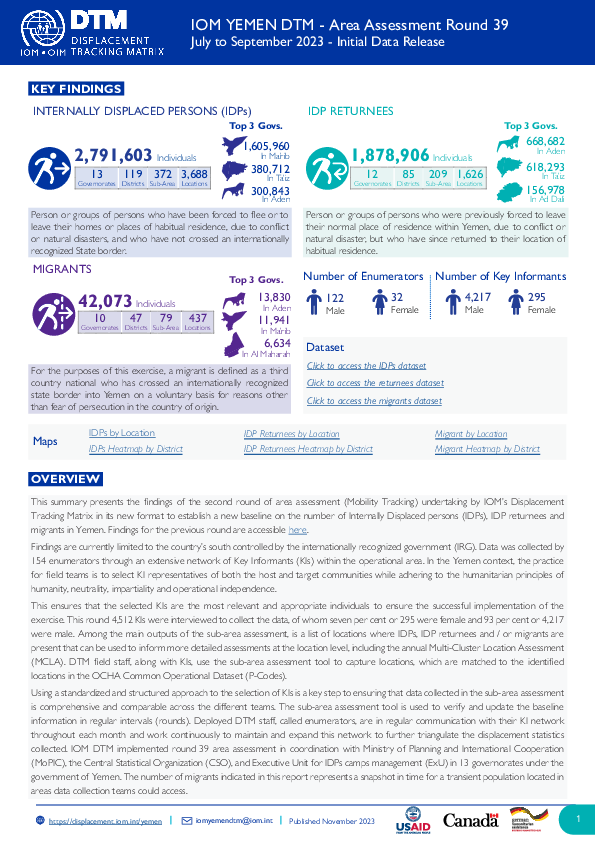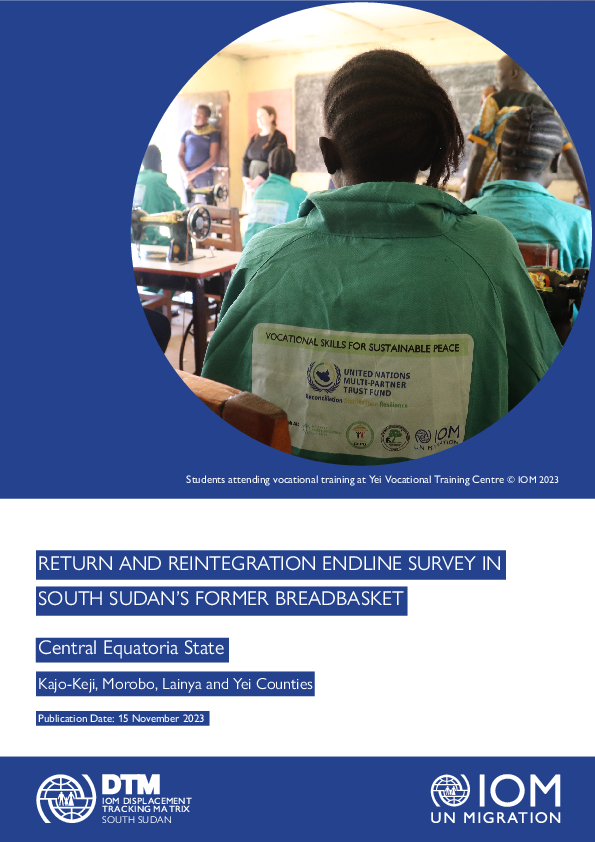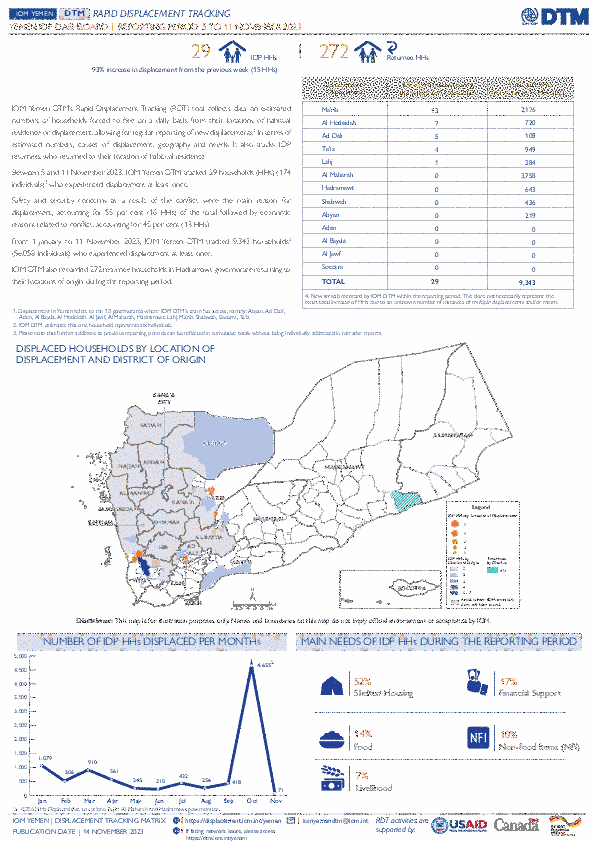-
Countries
-
Data and Analysis
-
Special Focus
-
Crisis Responses

Contact
DTM Yemen, DTMYemen@iom.int
Language
English
Location
Yemen
Period Covered
Jul 29 2023
Sep 20 2023
Activity
- Site Assessment
- Baseline Assessment
This summary presents the findings of round 39 Area Assessment (Mobility Tracking) undertaking by IOM’s Displacement Tracking Matrix in its new format to establish a new baseline on the number of Internally Displaced persons (IDPs), IDP returnees and migrants in Yemen. In round 39 of the Area Assessment carried out between July and September 2023, IOM DTM was able to increase the overall coverage since round 38 conducted in October and November 2022. Consequently, the numbers of recorded IDPs, IDP returnees and migrants as well as accessed locations and districts has equally increased.
Data was collected by 154 enumerators through an extensive network of Key Informants (KIs) within the operational area in coordination with Ministry of Planning and International Cooperation (MoPIC), the Central Statistical Organization (CSO) and Executive Unit for IDPs camps management (ExU) and humanitarian partners in 13 governorates of the government of Yemen.
In the Yemen context, the practice for field teams is to select Key Informant (KI) representatives of both the host and target communities while adhering to the humanitarian principles of humanity, neutrality, impartiality, and operational independence. This ensures that the selected KIs are the most relevant and appropriate individuals to ensure the successful implementation of the exercise.
In this round 39; 4,512 KIs were interviewed to collect the data, of whom seven per cent or 295 were female and 93 per cent or 4,217 were male.
Contact
DTM Mozambique, DTMMozambique@iom.int
Location
Mozambique
Activity
- Survey
- Community Perception
- Displacement Solutions
Period Covered
May 23 2023 -Jul 08 2023
The assessment aimed at informing targeted interventions in key areas of concern and provides initial evidence for programming which can be catalytic to move towards local integration of displaced communities in central Mozambique. By integrating a quantitative and qualitative approach, the report provides anopportunity for the voices of IDPs to be heard focusing mainly on the first five criteria to achieve durable solutions. The goal is to foster a comprehensive grasp of the situation and facilitate collaborative, evidence-based, decisionmaking regarding further solutions programming.
Population Groups
IDPs
Survey Methodology
Unit of Analysis Or Observation
Admin Area 2
Site
Type of Survey or Assessment
Household
Keywords
Geographical Scope Partial Coverage
Administrative boundaries with available data
The current dataset covers the following administrative boundaries

Contact
DTM Peru, IOMDTMPeru@iom.int
Language
English
Location
Peru
Period Covered
Oct 01 2023
Oct 31 2023
Activity
- Flow Monitoring
En el mes de octubre, las regiones fronterizas de Tumbes (norte del Perú) y Tacna (al sur del Perú), han continuado en Estado de Emergencia tras una nueva prórroga de 60 días decretada por el Gobierno peruano, la cual estará vigente hasta el 24 de noviembre del 2023. En la región de Tumbes, el Ministerio del Interior entregó 53 vehículos a los puestos policiales de la provincia de Zarumilla y el despliegue de 1,400 efectivos policiales en toda la región para garantizar la seguridad ciudadana. En la región de Tacna, las fuerzas militares y policiales continúan llevando a cabo tareas de vigilancia para reforzar la seguridad ciudadana y evitar ingresos irregulares a territorio peruano. En la región de Puno, el 12 de octubre se bloqueó el Puente Internacional de Ilave por 24 horas, el cual obstaculizó el tránsito hacia la frontera con Bolivia, vía Desaguadero yYunguyo.

Contact
dtmburundi@iom.int
Language
English
Location
South Sudan
Period Covered
Aug 11 2023
Aug 28 2023
Activity
- Survey
- Displacement Solutions
- Return Intention
To gain comprehensive insights into the dimensions of return and reintegration, the International Organization for Migration’s (IOM) Displacement Tracking Matrix (DTM) unit executed a targeted study within Southern Central Equatoria State, as part of the Reconciliation, Stabilization, and Resilience Trust Fund (RSRTF) project in August 2023. This phase of the study involves a meticulous difference analysis between the baseline and endline, designed to illuminate the shifts in the region’s circumstances and provide clarity regarding its current trajectory. By drawing comparisons between these surveys, the intention is to furnish stakeholders with actionable insights that can inform future humanitarian and developmental strategies, ensuring their relevance and effectiveness.
The findings obtained through the survey serve the purpose of establishing an endline and pinpointing the gaps and barriers that impact reintegration and stabilization efforts in Southern Central Equatoria State. This report presents a comprehensive analysis based on data that is representative of the county level. It is crucial to interpret the findings with an understanding of this scope. While the collected data provides valuable insights into the conditions and trends within the counties, its representation of smaller, sub-county divisions is more indicative in nature. In essence, while the report captures broader county-level trends, it may not precisely detail every nuance or variation present at sub-county levels.
Return and Reintegration Index
The Return and Reintegration Index combines data (the numerical version of the data) from eight indicators (8 key areas: housing, livelihoods, WASH, health, education, social cohesion, community stability, and protection) into a single number that provides an indication of the favourability of conditions (Stability Index) to the return and reintegration of displaced people. The calculation of the index was done at the household level.
The index score ranges from 0 to 10 where the higher the index the more favourable the conditions are for the return and reintegration of IDPs and refugees.
The calculation of the index was done at the household level and the results were aggregated at all administrative levels and by population type.
The average (mean) index score is 5.56 out of 10 with both the mean and median values indicating that the central tendency of the data is between 5 and 6.
Kajo-Keji and Morobo emerge as the two best-performing counties, as determined by the average (mean) index scores. While ‘Returnees’ and ‘IDPs’ report the highest mean index scores at 5.79 and 5.72 respectively, it’s important to note that the deviation among the different population groups is minimal, with all scores ranging between 5.3 and 5.7. This indicates a relatively uniform experience across the board, suggesting that while some groups are slightly better off, no single group is significantly outperforming or lagging the others in terms of the index score. Returnees and IDPs appear to experience relatively favorable conditions for return and reintegration compared to those who have been relocated.
Contact
DTM Yemen, iomyemendtm@iom.int
Location
Yemen
Activity
- Mobility Tracking
Period Covered
Nov 05 2023 -Nov 11 2023
From 1 January to 11 November 2023, IOM Yemen DTM tracked 9,343 households (HH) (56,058 Individuals) who experienced displacement at least once.
Between 5 and 11 November 2023, IOM Yemen DTM tracked 29 households (174 individuals) displaced at least once. The majority of people moved into/within the following governorates and districts:
- Ma’rib (13 HHs) – Ma’rib (9 HHs), Ma’rib City (2 HHs), Harib (2 HHs) districts. Most displacements in the governorate originated from Ma’rib and Shabwah.
- Al Hodeidah (7 HHs) – Hays (5 HHs), Al Khukhah (2 HHs) districts. Most displacements in the governorate originated from Al Hodeidah and Ta’iz.
- Ad Dali (5 HHs) – Ad Dali (3 HHs), Al Hasayn (2 HHs) districts. Most displacements in the governorate originated from Al Hodeidah and Ad Dali.
- Ta’iz (9 HHs) – Maqbanah (7 HHs), As Silw (1 HH), Al Mawasit (1 HH) districts.
- Al Hodeidah (6 HHs) – Zabid (2 HHs), Hays (2 HHs), Al Jarrahi (1 HH) districts.
- Ma’rib (3 HHs) – Al Jubah (2 HHs), Harib (1 HH) districts.
Population Groups
IDPs
Relocatees (previously internally displaced)
Returnee (Previously Displaced Abroad)
Survey Methodology
Unit of Analysis Or Observation
Admin Area 4
Site
Site or Location
Type of Survey or Assessment
Household
Key Informant
Keywords
Geographical Scope Partial Coverage
Administrative boundaries with available data
The current dataset covers the following administrative boundaries

Contact
DTM Yemen, iomyemendtm@iom.int
Language
English
Location
Yemen
Period Covered
Nov 05 2023
Nov 11 2023
Activity
- Rapid Emergency Registration
- Mobility Tracking
IOM Yemen DTM’s Rapid Displacement Tracking (RDT) tool collects data on estimated numbers of households forced to flee on a daily basis from their locations of origin or displacement, allowing for regular reporting of new displacements in terms of estimated numbers, geography, and needs. It also tracks returnees who returned to their location of origin.
From 1 January to 11 November 2023, IOM Yemen DTM tracked 9,343 households (HH) (56,058 Individuals) who experienced displacement at least once.
Between 5 and 11 November 2023, IOM Yemen DTM tracked 29 households (174 individuals) displaced at least once. The majority of people moved into/within the following governorates and districts:
- Ma’rib (13 HHs) – Ma’rib (9 HHs), Ma’rib City (2 HHs), Harib (2 HHs) districts. Most displacements in the governorate originated from Ma’rib and Shabwah.
- Al Hodeidah (7 HHs) – Hays (5 HHs), Al Khukhah (2 HHs) districts. Most displacements in the governorate originated from Al Hodeidah and Ta’iz.
- Ad Dali (5 HHs) – Ad Dali (3 HHs), Al Hasayn (2 HHs) districts. Most displacements in the governorate originated from Al Hodeidah and Ad Dali.
The majority of people moved from the following governorates and districts:
- Ta’iz (9 HHs) – Maqbanah (7 HHs), As Silw (1 HH), Al Mawasit (1 HH) districts.
- Al Hodeidah (6 HHs) – Zabid (2 HHs), Hays (2 HHs), Al Jarrahi (1 HH) districts.
- Ma’rib (3 HHs) – Al Jubah (2 HHs), Harib (1 HH) districts.

Contact
DTM Yemen, DTMYemen@iom.int
Language
English
Location
Yemen
Period Covered
Jul 01 2023
Sep 30 2023
Activity
- Flow Monitoring Survey
- Flow Monitoring
This dashboard compiles flow monitoring survey (FMS) data collected in Yemen between July and September 2023 and provides an analysis of migrants’ demographic and socio-economic profiles, including education and employment backgrounds, reasons for leaving their country of origin or habitual residence, future travel intentions, protection and challenges faced during the journey. Also included are migrants’ highest level of education achieved and their labour status prior to moving.
The migration routes in the southern part of Yemen are categorized along two main routes: the south-east route towards Shabwah, Hadramawt, and Al Maharah governorates and the north-east route towards Lahj and Ta’iz governorates. Both routes are traditionally travelled by a large number of migrants each year. Through the Flow Monitoring Registry tool, which focuses on total numbers of migrants (as opposed to the more detailed migrant profile established through the FMS).
DTM recorded 15,227 migrants entered Yemen through the south in the third quarter of 2023. This figure represents a significant decrease compared to the previous quarter, with nearly two thirds (62%) of all migrants were recorded in July. The remainder was recorded in August and September. The significant decrease observed since August is likely attributed to the ongoing joint military campaign initiated to combat smuggling and secure the coastline of Lahj, a well-known governorate for receiving the largest proportion of migrants. The campaign involved deploying troops, conducting raids, and establishing checkpoints.
During the third quarter of 2023, a total of 2,705 surveys were conducted. In Aden (667), Lahj (655), Ma’rib (487), Shabwah (409), Hadramawt (245) and Al Maharah (242). The overall number of surveys increased by one per cent over the previous quarter. The majority of respondents were young male adults between the age of 17 and 25 (78%) searching for economic opportunities (95%), most of whom were single (92%), attained primary education or less (60%), were currently unemployed (94%) and departed from rural areas (78%).
